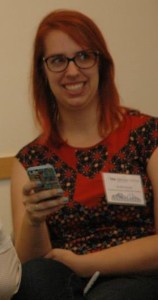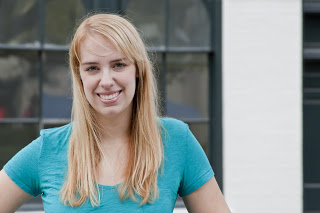Then recent design school grad and Disney intern Arielle Rassel told her story in 2012 of what she did to get a start in the themed entertainment industry. Arielle is now Associate Production Designer at Universal Creative, and will be the new NextGen Committee Chair for the Themed Entertainment Association (TEA), succeeding Clara Rice of Jack Rouse Associates. Top photo: Arielle in 2012.

[dropcap color=”#888″ type=”square”]W[/dropcap]hen I was a little girl, I wanted to grow up to be a Disney Princess – Belle, specifically. Never mind the fact that she was a cartoon character; kids will have their dreams.
As I grew up, princess dresses were set aside for paintbrushes, musical instruments, needle and thread. It wasn’t until high school, when I went backstage at Disney to march in a parade, that it dawned on me that I could still be a part of the magic. Never mind wearing the princess dresses (I’m too tall to play Belle, anyway) – I wanted to create them.
I’ve been lucky to have creative parents who have always supported my artistic dreams, in whatever capacity. I became a Fashion major at Savannah College of Art and Design (SCAD). Every day I hoped I was getting a little closer to my dream of designing costumes for Disney, but I still didn’t know quite how to get there – how, as a student, to get a foot in the door at this big company.
Two years and a change of major later, I started to figure things out.
SCAD has a unique program that allows a group of fifteen students (selected based on application) to spend their spring break with the Disney Imagineers in Orlando, exploring the parks in the wee morning hours before opening, and spending the days in the offices learning. I heard about the program just before its first year, and I knew I had to do it. The only problem? I was a junior who’d just changed majors (from fashion to interior design) and had hardly any portfolio of my new work to speak of. I didn’t get in.
Now, I’m the stubborn type. The program was planned again for a second year, and I had to find a way in. Peter Weishar, the dean of the School of Film and Digital Media, led the program [Weishar is now dean of dean of Florida State University’s College of Visual Arts, Theatre and Dance]. I approached him and asked what I could do. He recommended I learn about the industry by getting involved with the Themed Entertainment Association (TEA). With a brand-new student membership and last-minute hotel reservations in hand, I headed for Florida to attend TEA’s annual SATE conference.
The conference was eye-opening. I’d been focused on Disney, and Disney is the gold standard—but here were all these people representing dozens, hundreds even, of companies in the field, in disciplines ranging from engineering to fabrication to animatronics. I filled pages upon pages with notes and ideas from the sessions.
I was probably the youngest person at SATE, and I felt very green, to say the least. But people were friendly enough. There were maybe half a dozen students there, almost all grad students from Carnegie Mellon’s Entertainment Technology Center (ETC) program—I’m pretty sure I was the only undergraduate in attendance. I’m still friends with some of them today, and I imagine we’ll stay friends for life as we continue in the industry together (everyone keeps telling me this is a relationship-based business, and it certainly seems to be true).
 |
| Renderings: Arielle Rassel’s “Nautilus” senior project |
I’ll always be grateful for the way people reached out to me at that first conference. Some of the professionals I spoke to wanted to know how I’d found my way there. TEA was still formulating its student membership initiatives, and SCAD was just beginning to get involved. I was invited to dinner with folks from Themeworks, and I met designer Suzanne Sessions there as well. To be a student breaking bread with these people with such amazing experiences under their belts was both intimidating and exhilarating.
I left SATE feeling extremely encouraged, with a pocket full of business cards to boot. People wanted to stay in touch, to see how students in the industry are faring. TEA past president Steve Thorburn is one person I owe tremendous thanks to – it turned out that his company Thorburn Associates‘ North Carolina office is just down the street from my mom’s, and he invited me in for a day to see how things worked. It was a great experience, and yet another moment that showed me just how welcoming the industry is to young talent.
When applications rolled around again for SCAD’s off campus program with Walt Disney Imagineering, I sent in my materials, and this time I made it.
To say the least, it was the best week of my life. These parks that have been a second home to me my entire young existence—the places I escaped to in good times and bad—were laid out and explained in whole new ways, and I was confirmed in my determination to become a part of the professional community. I had my portfolio reviewed by multiple Imagineers—an opportunity few students are lucky enough to have. I got to go inside the Cinderella Suite in the castle and meet the designers behind it, which was literally a dream come true. Gary Landrum, our gracious and inspiring Imagineer-guide for the week, joked that he thought I might cry out of pure joy. I don’t think he was too far off.
That trip and my experiences connected to SATE prepared me for the daunting task of searching for internships, which I began shortly after returning to Savannah. Consulting the TEA Directory, I sent emails to at least 40 companies, hoping and praying that someone had a place for me. It was time to add real-world experience to what I’d been learning in classes.
Many companies never replied. Others said, “Sorry, stay in touch.” A select few didn’t have room for me, but wanted to help anyway, pointing me to their friends and contacts they thought might be helpful. Late in the game I had a breakthrough, with The Portico Group in Seattle, Washington. They’d never had an interior design student intern before, but they thought I might fit in well with their exhibit or interpretive design groups. I’d start in the fall.
Working at Portico was incredible. Everyone there was so welcoming and encouraging, and each day was an education. Getting to work on real-world projects and knowing I had an impact was exhilarating. I got to work on zoos, aquariums, even a visitor’s center for a rodeo town. I faced challenges I’d never encountered before, or even thought of, such as being tasked with finding gorilla-proof hammocks. (Solution: woven fire hoses. Who knew?)
Coming back to SCAD post-internship, I felt that much more prepared to take on my senior capstone project. I’m just finishing that up now: designing a 21st-century Interactive Aquarium for children and their families, called Nautilus: Key to the Seas.
In March, I attended the 2012 TEA Summit and Thea Awards. It had been almost two years since my last TEA event, and there were noticeable differences in the scope of student outreach. Instead of being one of six or seven students, I was one of at least 20, and this time it was a solid mix of undergraduate and graduate study students, ranging from first-years to those about to graduate. There were over seven schools represented there, and I was one of four SCAD students – three of us had also done the WDI trip together. Where, at SATE, people had seemed mostly curious about students in attendance, here they were warm and welcoming. I got to meet some of the designers in the field whom I really admire, and network with people who had helped create some of my favorite attractions. Everyone was full of words of advice and encouragement, and I couldn’t believe how much some people went out of their way to make us feel welcome.
The day after I got home from the events, I got a phone call from Disney. The internship I’d applied for came through! I’ll be starting in June, working in the Facility Asset Management department. It’s a dream come true, and I’m literally counting the days. There’s no way I could have made it there without the myriad of experiences I’ve had with the TEA and programs at SCAD, and I hope it becomes easier for students to find their way into the field.
SCAD is making big steps in introducing students to the field, like the WDI off campus program, and by starting a program in themed entertainment design, headed up by George Head and Mike Devine. Both are industry veterans with experience at WDI, among many other companies. I’m finishing up one of the classes now, and it’s been a great experience.
TEA continues to work hard to establish programs for students, including a mentoring initiative. I’m grateful that the organization provided me a student scholarship towards my attendance to the Summit and Thea Awards: I’m not sure I could have attended the events otherwise. There are so many people there who’ve been in the industry for decades and have worked on projects that have changed the face of entertainment design. They have a wealth of knowledge to offer and are clearly interested in sharing it via TEA’s expanding NextGen programs. On the flip side, there are many of us, young and eager, who can’t wait to break into the field but just aren’t sure where to get started.











